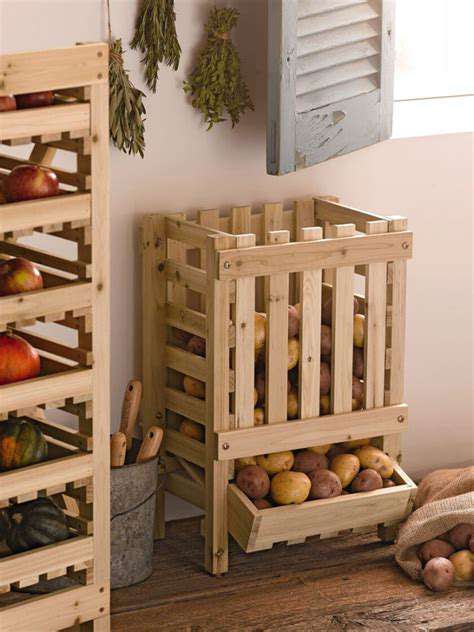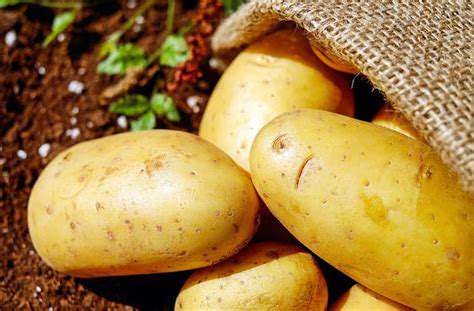How to Store Potatoes Long Term: Cool and Dark
Understanding Potato Varieties
Different potato varieties have varying storage needs and tolerances. Some potatoes are better suited for long-term storage than others. Understanding the specific characteristics of the variety you're working with is crucial for successful long-term potato preservation. Knowing the nuances of each variety allows you to tailor your storage methods for optimal results, preventing premature sprouting and decay. This knowledge is essential for maximizing the shelf life of your potatoes, ensuring you have a consistent supply of fresh, delicious spuds throughout the year.
For example, russet potatoes are known for their ability to store well, while smaller, more delicate varieties might not hold up as long under the same conditions. Knowing the type of potato you are working with will dictate the specific storage protocols you should follow.
Curing the Potatoes
Curing potatoes before storage is a vital step in maximizing their longevity. This process involves allowing the potatoes to slowly dry out after harvesting. This crucial step helps to heal any damage from the harvest process, reducing the chances of rot and decay. Proper curing significantly extends the storage life of your potatoes, ensuring they remain fresh and usable for weeks or even months.
Ideally, curing should occur in a cool, dark, well-ventilated area, keeping the potatoes in a single layer. This controlled environment allows the potatoes to naturally dry out, forming a protective skin that protects them from moisture and spoilage.
Proper Handling and Cleaning
Handling potatoes gently during harvest and cleaning is crucial to prevent bruising and damage. Bruises and cuts provide entry points for bacteria and fungi, leading to rapid deterioration. Gently removing any excess soil and debris while being mindful of the potato's integrity is important to maintain its overall quality.
Avoid harsh scrubbing or excessive force, as this can lead to damage that will shorten the shelf life of your potatoes significantly. Proper handling and gentle cleaning are key to ensuring the longevity of your potatoes.
Grading and Sorting the Potatoes
Sorting potatoes by size and quality is a necessary step for efficient storage and uniform storage conditions. This crucial step allows you to identify and separate potatoes that are damaged, diseased, or have other quality issues. Separating these potatoes from healthy ones is critical to preventing the spread of potential problems within the storage environment.
This practice ensures that the healthy potatoes have the best possible chance of maintaining their quality throughout the storage period, reducing the risk of spoilage and decay. Proper sorting is an essential part of good potato storage practices.
Temperature and Humidity Control
Maintaining the appropriate temperature and humidity levels is essential for long-term potato storage. Potatoes require a cool, dry environment to prevent sprouting and decay. Optimal conditions typically involve a temperature range of 45-50°F (7-10°C) and low humidity. These conditions are crucial for preventing early sprouting and the growth of mold and bacteria.
Storage Containers and Ventilation
Choosing the right storage containers is critical for maintaining proper ventilation and preventing moisture build-up. Use breathable containers or create a well-ventilated storage area to allow for air circulation. This prevents condensation and maintains optimal conditions for long-term storage.
Properly ventilated storage significantly reduces the risk of mold growth and rot, preserving the quality of your potatoes for extended periods.
Pest and Disease Prevention
Protecting potatoes from pests and diseases is a crucial aspect of successful long-term storage. Regularly inspect your potatoes for signs of infestation or disease. Proper storage conditions can help minimize these risks. Taking proactive steps can help ensure that your potatoes remain healthy and usable for a longer period. Monitoring for signs of pests and diseases is vital to maintaining the quality and longevity of your potatoes.
Creating the Ideal Storage Environment: Temperature and Darkness
Maintaining Ideal Temperatures
Temperature plays a crucial role in potato preservation, directly impacting their quality and longevity. Potatoes are highly sensitive to fluctuating temperatures, and maintaining a consistent, cool environment is key to preventing sprouting and decay. Ideally, storage temperatures should fall between 45°F and 50°F (7°C and 10°C). Temperatures above this range will accelerate sprouting, while lower temperatures can lead to chilling injury, resulting in undesirable changes in texture and flavor. Proper temperature control is critical for preserving the quality of your potatoes for extended periods.
Understanding the impact of temperature variations is essential. Exposure to warm temperatures during storage can significantly reduce the shelf life of your potatoes. On the other hand, maintaining a consistently cool environment slows down the metabolic processes within the potatoes, preserving their texture and preventing the formation of undesirable compounds that lead to spoilage.
The Importance of Darkness
Darkness is another critical aspect of creating an ideal potato storage environment. Potatoes, like many other root vegetables, are highly sensitive to light, which can trigger the production of enzymes that lead to undesirable changes in color, texture, and flavor. Light exposure can also cause potatoes to sprout prematurely, significantly reducing their storage life.
To ensure your potatoes remain in optimal condition, store them in a dark, cool environment. Avoid placing them in areas exposed to direct sunlight or artificial light. A well-ventilated, dark storage area is ideal for preventing the development of these enzymatic processes. Darkness is crucial for maintaining the quality and freshness of your stored potatoes.
Ventilation and Humidity Control
While temperature and darkness are paramount, proper ventilation and humidity control are equally important considerations for optimal potato storage. Adequate ventilation helps to prevent the buildup of moisture, which can lead to mold growth and spoilage. A well-ventilated storage area allows for the circulation of air, reducing the risk of moisture accumulation and maintaining a dry environment around the potatoes.
Maintaining appropriate humidity levels is also critical. Potatoes should be stored in an environment with a relatively low humidity level, ideally between 85% and 90%. High humidity levels can lead to excessive moisture build-up around the potatoes, creating ideal conditions for mold and rot. Maintaining a well-ventilated environment will indirectly help with the humidity control within the storage area.

Monitoring and Maintaining Your Potato Storage: Regular Checks

Monitoring System Performance
A crucial aspect of maintaining optimal performance in your system involves continuous monitoring. This proactive approach allows you to identify potential bottlenecks or anomalies early on, preventing significant disruptions and costly downtime. Regularly tracking key metrics, such as CPU utilization, memory consumption, and network traffic, is essential for achieving this. By closely observing these metrics, you can proactively address issues before they escalate into major problems.
Implementing robust monitoring tools can provide valuable insights into system behavior. These tools often offer real-time dashboards and alerts, enabling you to quickly respond to any emerging issues. By utilizing these tools effectively, you can gain a comprehensive understanding of the system's health and performance. This understanding empowers you to make informed decisions regarding resource allocation and optimization.
Maintaining System Integrity
Maintaining the integrity of your system is paramount for its continued functionality and stability. This involves regularly updating software, applying security patches, and performing routine maintenance tasks. These proactive measures help mitigate vulnerabilities and prevent potential security breaches. Keeping your system updated ensures it is protected against known exploits.
Regular backups are another critical component of maintaining system integrity. Data loss can have significant consequences, impacting productivity and potentially causing financial losses. Implementing a robust backup strategy ensures data safety and the ability to quickly restore systems in case of unforeseen events. This preventative measure is crucial for safeguarding your precious data and avoiding potential catastrophe.
Optimizing System Resources
System optimization is a continuous process aimed at enhancing efficiency and performance. This involves identifying and addressing bottlenecks in your system, such as inefficient algorithms or excessive resource consumption. Analyzing resource usage patterns helps identify areas for improvement and ultimately boosts overall system performance. Proper resource allocation is key to ensuring optimal operation.
Regularly reviewing and adjusting system configurations can significantly impact overall performance. This might involve optimizing database queries, fine-tuning server settings, or implementing caching strategies. By understanding your system's specific needs and making necessary adjustments, you can improve overall performance. Implementing these changes effectively can lead to substantial performance gains.
Addressing Potential Issues
Proactively addressing potential issues is vital for maintaining a stable and reliable system. This includes identifying and resolving any errors or warnings that may arise during operation. Promptly addressing these issues can prevent minor problems from escalating into major disruptions. Addressing these issues quickly and efficiently is essential for maintaining system stability.
Developing and implementing a comprehensive troubleshooting plan is vital for handling system issues effectively. This plan should outline procedures for identifying, isolating, and resolving problems. This proactive approach minimizes downtime and maintains system reliability. A well-defined troubleshooting plan is a crucial element of a proactive approach to system maintenance.
- Exploring Italian Pasta Dishes: Beyond Spaghetti Bolognese
- Quick Weeknight Meals: From Pantry to Plate
- Discovering Brazilian Feijoada: A Hearty Stew
- High Protein Vegan Meals: Delicious Plant Based Power
- Baking with Alternative Flours: Gluten Free and Beyond
- Keto Desserts: Guilt Free Sweet Treats
- How to Choose the Freshest Seafood at Your Market
- Speedy Weeknight Dinners: 15 Minute Chicken Stir Fry
- Safely Defrosting Food: Best Practices to Prevent Bacteria
- Diabetic Friendly Main Dishes: Balanced and Flavorful
- Cooking with Spices: A Beginner's Flavor Guide
- High Fiber Diet Benefits: Recipes for Digestive Health